
A Wellington boot, often shortened to welly, and also known as a gumboot, rubber boot, or rain boot, is a type of waterproof boot made of rubber.
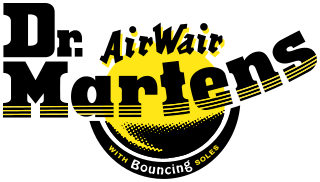
Dr. Martens, also known as Doc Martens, Docs, or DMs, is a British footwear and clothing brand, headquartered in Wollaston, Northamptonshire, England. Although most known for its footwear, the company also makes a range of accessories including clothing and bags. The footwear is distinguished by its air-cushioned sole, upper shape, welted construction, and yellow stitching.
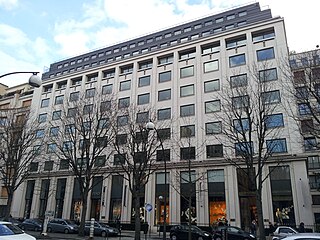
LVMH Moët Hennessy Louis Vuitton SE, commonly known as LVMH, is a European multinational holding company and conglomerate that specializes in luxury goods and has its headquarters in Paris, France. The company was formed in 1987 through the merger of fashion house Louis Vuitton with Moët Hennessy, which had been established by the 1971 merger between the champagne producer Moët & Chandon and the cognac producer Hennessy. In April 2023, LVMH became the first European company to surpass a valuation of $500 billion. In 2023, the company was ranked 47th in the Forbes Global 2000.
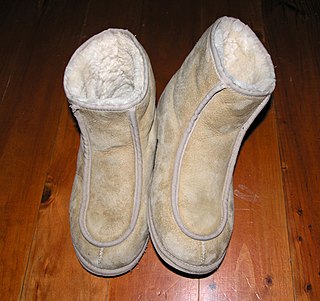
Ugg boots are a unisex style of sheepskin boot originating in Australia. The boots are typically made of twin-faced sheepskin with fleece on the inside, a tanned outer surface and a synthetic sole. The term "ugg boots" originated in Australia, initially for utilitarian footwear worn for warmth, and which were often worn by surfers during the 1960s. In the 1970s, the boots were introduced to the surf culture of the United Kingdom and the United States. Sheepskin boots became a fashion trend in the U.S. in the late 1990s and a worldwide trend in the mid-2000s. In Australia, they are worn predominantly as slippers and often associated with daggy fashion sense and bogan culture.

An Australian work boot is a style of work shoe, typically constructed with a leather upper bound together with elastic sides and pull tabs on the front and back of the boot. The shoe lacks a tongue, and laces, and often contains a steel toe cap for occupational health and safety reasons. When the shoe contains a steel cap they are often known as "safety boots" or "steel toe boots". The boots generally lack an inner lining. The sole is generally polyurethane and the leather uppers are treated to be resistant to hot water, fats and mild alkaline and acid solutions.
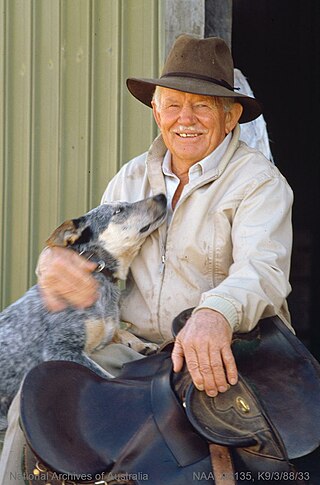
Reginald Murray Williams was an Australian bushman and entrepreneur who rose from a swagman to a millionaire. He was born at Belalie North near Jamestown in the Mid North of South Australia, 200 kilometres (120 mi) north of Adelaide CBD, into a pioneering settler family working and training horses. Williams had many adventures in Australia's rugged outback as a bushman, and became known for creating an Australian style of bushwear clothing and footwear recognised worldwide and the company that bore his name.

Football boots, also known as cleats or soccer shoes in North American English, are a type of shoe worn when playing association football (soccer), most of its variations, and some games that are played on the same surface. Those designed for grass pitches have studs on the outsole to aid grip. Modern football boots are no longer truly traditional boots, as they do not cover the ankle. As with most other types of athletic footwear, their basic design and appearance have converged with those of sneakers since the 1960s.
The Adnyamathanha are a contemporarily formed grouping of several distinct Aboriginal Australian peoples of the northern Flinders Ranges, South Australia. The ethnonym Adnyamathanha was an alternative name for the Wailpi but the contemporary grouping also includes the Guyani, Jadliaura, Pilatapa and sometimes the Barngarla peoples. The origin of the name is in the words "adnya" ("rock") and "matha".
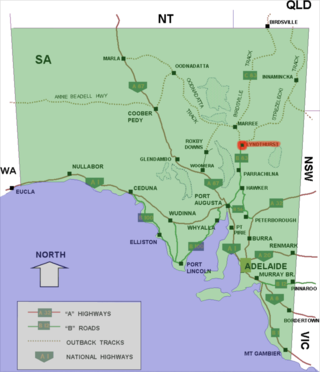
Lyndhurst is a town in north-east South Australia which is at the crossroads of the Strzelecki Track and the Oodnadatta Track. It began as a railway siding in 1878.

The Adnyamathanha language, also known as yura ngarwala natively and Kuyani, also known as Guyani and other variants, are two closely related Australian Aboriginal languages. They are traditional languages of the Adnyamathanha of and the Kuyani peoples, of the Flinders Ranges and to the west of the Flinders respectively, in South Australia.
Nordica is an Italian manufacturing company of winter sports products, focusing on skiing. Based in Giavera del Montello, Nordica is currently a division of Tecnica Group, after it was acquired from Benetton in 2003.

Tod's S.p.A. is an Italian luxury fashion house specialized in footwear, apparel, and related accessories headquartered in Marche, Italy. Its core branding includes an oval nameplate and roaring lion, with signature brown and orange packaging. The company is an influencer in the Sprezzatura fashion movement. Its highest-selling products are pebble-sole “Gommino” driving shoes, leather (suede) loafers, boots, sneakers, and handbags.

Berluti is a French leather maker that manufactures menswear, especially the leather finishing of calfskin, kangaroo leather and alligator skin in its production of shoes and boots. It makes leather belts, bags, and wallets, as well as bespoke and ready-to-wear garments. Established in 1895 by Italian Alessandro Berluti of Marche, Berluti is based in Paris on rue Marbeuf. The brand was bought by LVMH in 1993.
Nepabunna, also spelt Nipapanha, is a small community in the northern Flinders Ranges in north-eastern South Australia, about 600 kilometres (370 mi) north of Adelaide. It is located just west of the Gammon Ranges, and the traditional owners are the Adnyamathanha people.

John Andrew Henry Forrest, nicknamed Twiggy, is an Australian businessman. He is best known as the former CEO of Fortescue Metals Group (FMG), and has other interests in the mining industry and in cattle stations.
Rossi Boots is a South Australian boot manufacturer founded in 1910. The business headquarters is in Kilburn, South Australia.
L Catterton is an American multinational private equity firm. Founded in Greenwich, Connecticut in 1989, the fund has made over 250 investments in brands across all segments of the consumer industry. The firm is led by co-CEOs J. Michael Chu and Scott Dahnke. Originally Catterton Partners, the fund merged with Bernard Arnault's family office and LVMH in 2016 to create L Catterton.
Ugg boots trademark disputes are the disputes between some footwear manufacturers, as to whether "ugg" is a protected trademark, or a generic term and thus ineligible for trademark protection. In Australia and New Zealand, where "Ugg" is a generic term for the style of footwear, 702 registered trademarks include the term "Ugg" in various logos and designs. By contrast, UGG is a registered trademark of the California-based company Deckers Outdoor Corporation in over 130 countries worldwide, including the U.S., the European Union, and China.

Henbury Station is a cattle station in the Northern Territory of Australia. In March 2022 Henbury was purchased by Tim Edmunds for A$32 million, including its 3500 cattle.
Tattarang is an Australian private investment company owned by Andrew Forrest and his family. Tattarang invests in a diverse range of businesses across agri-food, energy, health technology, property, resources, and lifestyle. The group is made up of six business divisions: Fiveight, Harvest Road, Squadron Energy, Tenmile, Wyloo Metals and Z1Z.


















